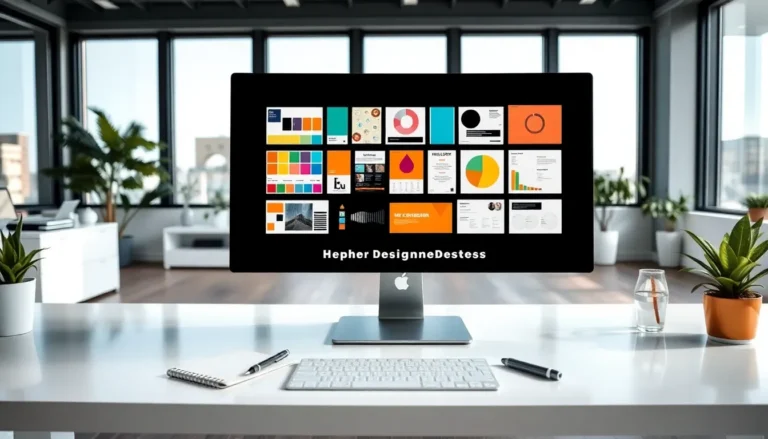Table of Contents
ToggleDesign ideas can spark creativity like a caffeine jolt on a Monday morning. Whether it’s doodling in a sketchbook or crafting a detailed blueprint, drawing serves as the ultimate playground for ideas. It’s where visions come to life, and who doesn’t want to turn their wildest thoughts into something tangible?
What Is Design Ideas Drawing?
Design ideas drawing encompasses a range of creative practices aimed at visualizing concepts. It serves as a critical medium for artists, designers, and architects to express their visions effectively. By sketching, individuals capture their thoughts, enabling clearer communication of complex ideas.
Individuals utilize various styles in design ideas drawing. Doodling provides freedom to explore without constraints, while precise blueprints convey detailed specifications. Both methods allow for experimentation, aiding in the refinement of initial concepts.
This practice facilitates collaboration among creatives. Sharing sketches fosters dialogue, providing a platform for feedback. Artists can brainstorm, iterate, and evolve their ideas, leading to more refined outcomes.
Visualizing concepts in this way enhances project development. Renderings bring depth to imaginative concepts, offering insights into potential challenges. These drawings often guide the decision-making process, acting as a reference for further development.
Many tools and techniques enhance design ideas drawing. Digital software offers versatility, while traditional mediums like pencil and paper maintain tactile qualities. Each choice influences the final presentation, adding personal touches that resonate with the creator’s intent.
One can also observe that diverse sectors utilize design ideas drawing for various purposes. From product design to architectural planning, this practice plays an integral role in turning ideas into reality. Ultimately, it stands as a valuable skill fostering innovation and creativity across disciplines.
Techniques for Effective Design Ideas Drawing
Effective design ideas drawing hinges on specific techniques that enhance creativity and clarity in visual representation.
Sketching Fundamentals
Understanding sketching fundamentals provides a solid foundation for transforming ideas into visuals. Artists and designers leverage line quality, shading, and proportions to convey depth and dimension. Practicing basic shapes enhances observational skills, making it easier to capture complex forms. Regularly creating quick sketches helps develop spontaneity and fluidity in drawing styles. Mastering these techniques fosters confidence, paving the way for more intricate designs.
Using Digital Tools
Utilizing digital tools revolutionizes the design ideas drawing process. Software applications, like Adobe Illustrator and Procreate, offer versatility in creating and editing designs. Digital platforms enable instant access to various colors, textures, and layers, facilitating experimentation without the constraints of traditional mediums. Each project can benefit from features such as undo options and cloud storage for seamless collaboration. Choosing the right tools amplifies creativity, allowing for refined presentations that engage viewers effectively.
Inspiration Sources for Design Ideas Drawing
Drawing inspiration from various sources enhances creativity and enriches design ideas. Exploring different themes broadens perspectives and nurtures innovation.
Nature and Environment
Natural landscapes and elements play a crucial role in inspiring design ideas. Observing the intricate details of flowers, textures of bark, or the fluidity of water sparks creativity. Wildlife also offers unique forms and colors that can influence artistic direction. Designers might draw from seasonal changes, capturing the essence of autumn leaves or winter landscapes. Analyzing natural patterns, such as the Fibonacci sequence or fractals, provides a foundation for visually appealing designs. Integrating environmental elements fosters a connection to the world and encourages sustainable practices.
Art and Culture
Artistic movements and cultural traditions serve as significant sources of inspiration. Different styles, such as Impressionism or Abstract, present varied approaches to form and color. Cultural artifacts, including textiles, pottery, and sculpture, reflect unique aesthetic values that can inspire new designs. Exploring global art scenes encourages cross-cultural dialogue, blending techniques and ideas. Historical context enriches understanding, allowing designers to reinterpret classic themes with modern aesthetics. Engaging with diverse artistic expressions cultivates a vibrant design vocabulary, making the drawing process more dynamic and engaging.
Practical Tips for Improving Your Design Ideas Drawing
Mastering sketching techniques enhances the clarity of design ideas. Focus on line quality to create expressive marks that convey emotion. Practice shading to add depth, allowing your drawings to pop off the page. By emphasizing proportions, artists can ensure accurate representation of objects, which aids in conveying intent.
Exploring basic shapes also strengthens observational skills. Regular sketching of simple forms leads to better understanding of structure. Quick sketches foster creativity by encouraging spontaneity, allowing thoughts to flow freely onto paper. Embrace mistakes during this process; they often lead to unexpected discoveries.
Incorporating digital tools enhances drawing capabilities significantly. Programs like Adobe Illustrator provide versatile options for refining designs. Utilizing Procreate allows for a hands-on approach, combining traditional techniques with modern technology. Leveraging these tools also opens doors to various design elements, facilitating experimentation and encouraging innovation.
Seeking inspiration from various sources enriches the drawing process. Nature offers abundant themes, where observing intricate details can spark new ideas. Artistic movements present opportunities to explore diverse styles, which can invigorate personal expressions. Engaging with cultural traditions fosters a broader design vocabulary that enhances creativity.
Fostering regular feedback loops with peers promotes collaborative growth. Sharing sketches invites constructive criticism, refining the drawing approach. Joining community art groups provides exposure to fresh perspectives, stimulating creative thinking. Participating in workshops opens further avenues for skill development, helping artists expand their repertoire.
Utilizing these tips not only improves design ideas drawing but also nurtures personal growth in creative practices.
Design ideas drawing serves as a powerful catalyst for creativity and innovation. By embracing various techniques and tools, individuals can elevate their artistic expression and effectively communicate complex concepts. Regular practice and exploration of diverse inspirations not only enhance drawing skills but also enrich the overall creative process.
Engaging with peers and participating in collaborative environments fosters growth and opens new avenues for exploration. Ultimately, design ideas drawing is more than just a skill; it’s a vital practice that nurtures imagination and transforms visions into reality. Embracing this art form can lead to remarkable breakthroughs in design across multiple disciplines.







